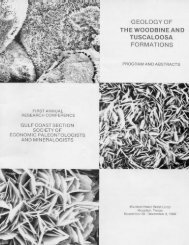Petroleum Systems of Deep-Water Basins - Gulf Coast Section SEPM
Petroleum Systems of Deep-Water Basins - Gulf Coast Section SEPM
Petroleum Systems of Deep-Water Basins - Gulf Coast Section SEPM
Create successful ePaper yourself
Turn your PDF publications into a flip-book with our unique Google optimized e-Paper software.
A “Healed Slope” Model for the Deposition <strong>of</strong> Turbidite<br />
Reservoirs Applied to Shell’s Zia and Oregano<br />
Discoveries in the <strong>Deep</strong> <strong>Water</strong> <strong>Gulf</strong> <strong>of</strong> Mexico<br />
Bruce T. Mitchell<br />
Michael C. Dean<br />
Shell Exploration and Production Company<br />
P.O.Box 61933<br />
New Orleans, Louisiana 70161<br />
Abstract<br />
Shell Exploration & Production Company has recently made two smaller-volume discoveries in the deepwater<br />
<strong>Gulf</strong> <strong>of</strong> Mexico: Zia (Mississippi Canyon 496) in 1998 and Oregano (Garden Banks 559) in 1999. Neither <strong>of</strong> these<br />
discoveries is large enough for Shell to develop using a fixed production facility, but they become pr<strong>of</strong>itable if tied<br />
back to an existing host platform as a subsea development. An understanding <strong>of</strong> the depositional environment and reservoir<br />
architecture <strong>of</strong> the main pay sands at Zia and Oregano has been an important component <strong>of</strong> the detailed<br />
development planning that is necessary in order to optimally locate the development wells.<br />
The primary oil-bearing reservoirs at both Oregano and Zia are examples <strong>of</strong> sands that have been deposited in<br />
what has been referred to as a “healing phase” <strong>of</strong> turbidite deposition (Booth et al., 2000). Elsewhere in the region<br />
around the discoveries, the stratigraphic interval in which the pay sands occur is normally a bypass facies assemblage<br />
(e.g., Prather et al., 1998), as most <strong>of</strong> the sand in the vicinity is diverted out into the basins in deeper water. At Oregano<br />
and Zia, however, locally unique conditions have resulted in “healing phase” deposition instead. A local<br />
topographic indentation or change in slope has formed along the seafloor, possibly in response to salt movement<br />
nearby. Turbidite sands transported down from the shelf encounter the break in slope at the edge <strong>of</strong> the indentation<br />
and are deposited as a local area <strong>of</strong> amalgamated turbidite sheet sands. The area <strong>of</strong> topographic relief is quickly filled<br />
or “healed over” by the deposition <strong>of</strong> the initial sands and the system transitions back into the bypass mode. Subsequent<br />
turbidite sands may be deposited on top <strong>of</strong> the “healing phase” sheets as amalgamated channel complexes. In<br />
the case <strong>of</strong> both Oregano and Zia, the channel sands cut into the underlying sheet sands and may improve reservoir<br />
connectivity. Finally, as the last slight topographic variations are smoothed out, the true bypass system is restored.<br />
Younger shale-filled channels that <strong>of</strong>ten partially cut into the underlying reservoir and help to trap the accumulation<br />
are observed in the 3D seismic data volume.<br />
In turbidite reservoirs formed by this type <strong>of</strong> process, the proximal end <strong>of</strong> the amalgamated sheet sand complex is<br />
a higher energy depositional setting, in which there is <strong>of</strong>ten a predominance <strong>of</strong> sand-on-sand contacts. This is also the<br />
place where the overlying amalgamated channel complexes may cut into the sheet sands beneath, providing many different<br />
mechanisms for interconnected sand bodies. The distal end, by contrast, will have a lower overall net-to-gross<br />
and interbedded shales that can isolate portions <strong>of</strong> the reservoir. Understanding these components <strong>of</strong> the depositional<br />
model and their areal relationship to the depth structure <strong>of</strong> the accumulation is important in planning a successful<br />
development.<br />
46

















